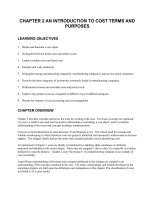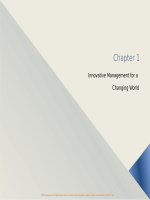Management 12e richard draft chapter 02
Bạn đang xem bản rút gọn của tài liệu. Xem và tải ngay bản đầy đủ của tài liệu tại đây (448.78 KB, 29 trang )
Chapter 2
The Evolution of Management Thinking
© 2016 Cengage Learning. All Rights Reserved. May not be scanned, copied or duplicated, or posted to a publicly accessible website, in whole or in part.
Management and Organization
Studying management history helps your
conceptual skills
Social forces – aspects of a culture that guide
and influence relationships among people
Political forces – influence of political and legal
institutions on people and organizations
Economic forces – the availability, production,
and distribution of resources
© 2016 Cengage Learning. All Rights Reserved. May not be scanned, copied or duplicated, or posted to a publicly accessible website, in whole or in part.
2
2.1 Management Perspectives
over Time
© 2016 Cengage Learning. All Rights Reserved. May not be scanned, copied or duplicated, or posted to a publicly accessible website, in whole or in part.
3
Classical Perspective
Emerged during the nineteenth and early
twentieth centuries
Rise of the factory system
Issues regarding structure, training, and
employee satisfaction
Large, complex organizations required new
approaches to coordination and control
© 2016 Cengage Learning. All Rights Reserved. May not be scanned, copied or duplicated, or posted to a publicly accessible website, in whole or in part.
4
Classical Perspective
Three subfields:
Scientific management
Bureaucratic organizations
Administrative principles
© 2016 Cengage Learning. All Rights Reserved. May not be scanned, copied or duplicated, or posted to a publicly accessible website, in whole or in part.
5
Scientific Management
Improve efficiency and labor productivity
through scientific methods
Frederick Winslow Taylor proposed that
workers “could be retooled like machines”
Management decisions would be based on
precise procedures based on study
© 2016 Cengage Learning. All Rights Reserved. May not be scanned, copied or duplicated, or posted to a publicly accessible website, in whole or in part.
6
Scientific Management
Henry Gantt developed the Gantt chart to
measure and plan work
The Gilbreths pioneered time and motion
studies to promote efficiency
© 2016 Cengage Learning. All Rights Reserved. May not be scanned, copied or duplicated, or posted to a publicly accessible website, in whole or in part.
7
2.2 Characteristics of
Scientific Management
© 2016 Cengage Learning. All Rights Reserved. May not be scanned, copied or duplicated, or posted to a publicly accessible website, in whole or in part.
8
Bureaucratic Organizations
Max Weber, a German theorist, introduced the
concepts
Manage organizations on impersonal, rational
basis
Organization depends on rules and records
© 2016 Cengage Learning. All Rights Reserved. May not be scanned, copied or duplicated, or posted to a publicly accessible website, in whole or in part.
9
Bureaucratic Organizations
Managers use power instead of personality to
delegate
Although important productivity gains
come from this foundation, bureaucracy
has taken on a negative tone
© 2016 Cengage Learning. All Rights Reserved. May not be scanned, copied or duplicated, or posted to a publicly accessible website, in whole or in part.
10
2.3 Characteristics of
Weberian Bureaucracy
© 2016 Cengage Learning. All Rights Reserved. May not be scanned, copied or duplicated, or posted to a publicly accessible website, in whole or in part.
11
Administrative Principles
Focused on the entire organization
Henri Fayol, a French mining engineer, was a major
contributor
14 general principles of management; many still used
today:
Unity of command
Division of work
Unity of direction
Scalar chain
© 2016 Cengage Learning. All Rights Reserved. May not be scanned, copied or duplicated, or posted to a publicly accessible website, in whole or in part.
12
Administrative Principles
Identified five functions of management:
Planning
Organizing
Commanding
Coordinating
Controlling
© 2016 Cengage Learning. All Rights Reserved. May not be scanned, copied or duplicated, or posted to a publicly accessible website, in whole or in part.
13
Humanistic Perspective:
Early Advocates
Understand human behaviors, needs, and
attitudes in the workplace
Mary Parker Follett and Chester Barnard
Contrast to scientific management - Importance
of people rather than engineering techniques
© 2016 Cengage Learning. All Rights Reserved. May not be scanned, copied or duplicated, or posted to a publicly accessible website, in whole or in part.
14
Humanistic Perspective:
Early Advocates
Empowerment: facilitating instead of
controlling
Recognition of the informal organization
Introduced acceptance theory of authority
© 2016 Cengage Learning. All Rights Reserved. May not be scanned, copied or duplicated, or posted to a publicly accessible website, in whole or in part.
15
Humanistic Perspective:
Human Relations Movement
Effective control comes from within the employee
Hawthorne studies were key contributor
Human relations played key variable in increasing
performance
Employees performed better when managers
treated them positively
Strongly shaped management practice and
research
© 2016 Cengage Learning. All Rights Reserved. May not be scanned, copied or duplicated, or posted to a publicly accessible website, in whole or in part.
16
Humanistic Perspective:
Human Resources Perspective
From worker participation and considerate
leadership to managing work performance
Combine motivation with job design
Maslow and McGregor extended and
challenged current theories
Maslow’s Hierarchy
Theory X and Theory Y
© 2016 Cengage Learning. All Rights Reserved. May not be scanned, copied or duplicated, or posted to a publicly accessible website, in whole or in part.
17
2.4 Theory X and Theory Y
© 2016 Cengage Learning. All Rights Reserved. May not be scanned, copied or duplicated, or posted to a publicly accessible website, in whole or in part.
18
Humanistic Perspective:
Behavioral Sciences Approach
Scientific methods + sociology, psychology,
anthropology, economics to develop theories
about human behavior and interaction in an
organizational setting
Organizational development – field that uses
behavioral sciences to improve organization
© 2016 Cengage Learning. All Rights Reserved. May not be scanned, copied or duplicated, or posted to a publicly accessible website, in whole or in part.
19
Humanistic Perspective:
Behavioral Sciences Approach
Other strategies based on behavioral science:
Matrix organizations
Self-managed teams
Corporate culture
Management by wandering around
© 2016 Cengage Learning. All Rights Reserved. May not be scanned, copied or duplicated, or posted to a publicly accessible website, in whole or in part.
20
Quantitative Perspective
Also referred to as management science
Use of mathematics and statistics to aid
management decision making
Enhanced by development and perfection of the
computer
Operations management focuses on the
physical production of goods and services
© 2016 Cengage Learning. All Rights Reserved. May not be scanned, copied or duplicated, or posted to a publicly accessible website, in whole or in part.
21
Quantitative Perspective
Information technology – focuses on
technology and software to aid managers
Quants – financial managers who base their
decisions on complex quantitative analysis
© 2016 Cengage Learning. All Rights Reserved. May not be scanned, copied or duplicated, or posted to a publicly accessible website, in whole or in part.
22
Recent Trends: Systems
Thinking
The ability to see the distinct elements of a situation as
well as the complexities
System – set of interrelated parts that function as a
whole to achieve a common purpose
Subsystems – are parts of the system that are all
interconnected
Synergy – the whole is greater than the sum of its parts
Managers must understand subsystem
interdependence and synergy
© 2016 Cengage Learning. All Rights Reserved. May not be scanned, copied or duplicated, or posted to a publicly accessible website, in whole or in part.
23
Exhibit 2.5 Circles of Causality
© 2016 Cengage Learning. All Rights Reserved. May not be scanned, copied or duplicated, or posted to a publicly accessible website, in whole or in part.
24
Recent Trends:
Contingency View
Every situation is unique
Managers must determine what method will
work
Managers must identify key contingencies for
the current situation
Organizational structure should depend upon
industry and other variables
© 2016 Cengage Learning. All Rights Reserved. May not be scanned, copied or duplicated, or posted to a publicly accessible website, in whole or in part.
25









